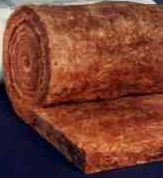fiberglass insulation
Fiberglass insulation is a common type of insulation, composed of extremely fine pink, yellow, or white glass fibers. It is used in two different insulation forms: blanket (batts and rolls) and loose-fill.
 |
Fiberglass blanket (batts and rolls) insulation
Manufacturers now produce medium- and high-density fiberglass batt insulation products that have slightly higher R-values than previous varieties. The denser products are intended for insulating areas with limited cavity space, such as cathedral ceilings.
High-density fiberglass batts for a 2–4 inch (51–102 millimeter) stud-framed wall has an R-15 value, compared to R-11 for "low density" types. A medium-density batt offers R-13 for the same space. High-density batts for a 2–6 inch (51–152 millimeter) frame wall offer R-21. High-density batts for an 8.5 inch (216 millimeter) spaces offer about an R-30 value. R-38 for 12 inch (304 millimeter) spaces is also available.
One unconventional fibrous insulation product combines two types of glass, which are fused together. As the two materials cool during manufacturing, they form random curls of material. This material is less irritating and possibly safer to work with. It also requires no chemical binder to hold the batts together, and the material even comes in a perforated plastic sleeve to assist in handling.
Fiberglass loose-fill insulation
Fiberglass loose-fill insulation is made from molten glass that is spun or blown into fibers. Most manufacturers use 20-30% recycled glass content. Loose-fill insulation must be applied using an insulation blowing machine; it is designed for open-blow applications (such as attic spaces) or closed-cavity applications (such as those found inside walls or covered attic floors).
One variation of fiberglass loose-fill insulation is the blown-in-blanket (BIB). The BIB is similar to the more common "wet-spray" cellulose in that the material is mixed with a latex adhesive, misted with water to activate the glue, and blown into wall stud cavities. Tests have shown that walls insulated with a BIB system are significantly better filled than those with other forms of fiberglass insulation, such as batts.
